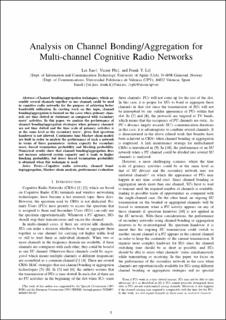| dc.contributor.author | Jiao, Lei | |
| dc.contributor.author | Pla, Vincent | |
| dc.contributor.author | Li, Frank Yong | |
| dc.date.accessioned | 2010-11-10T09:35:02Z | |
| dc.date.available | 2010-11-10T09:35:02Z | |
| dc.date.issued | 2010 | |
| dc.identifier.citation | Jiao, L., Pla, V. & Li, F. Y. (2010). Analysis on channel bonding/aggregation for multi-channel cognitive radio networks. In 2010 European Wireless Conference. IEEE. | en_US |
| dc.identifier.isbn | 978-1-4244-5999-5 | |
| dc.identifier.uri | http://hdl.handle.net/11250/137787 | |
| dc.description.abstract | Channel bonding/aggregation techniques, which assemble several channels together as one channel, could be used in cognitive radio networks for the purpose of achieving better bandwidth utilization. In existing work on this topic, channel bonding/aggregation is focused on the cases when primary channels are time slotted or stationary as compared with secondary users' activities. In this paper, we analyze the performance of channel bonding/aggregation strategies when primary channels are not time slotted and the time scale of primary activities is at the same level as the secondary users', given that spectrum handover is not allowed. Continuous time Markov chain models are built in order to analyze the performance of such a network in terms of three parameters: system capacity for secondary users, forced termination probability and blocking probability. Numerical results show that channel bonding/aggregation does not increase achieved system capacity and it leads to higher blocking probability, but lower forced termination probability is obtained when this technique is used. | en_US |
| dc.language.iso | eng | en_US |
| dc.publisher | IEEE | en_US |
| dc.title | Analysis on channel bonding/aggregation for multi-channel cognitive radio networks | en_US |
| dc.type | Chapter | en_US |
| dc.type | Peer reviewed | en_US |
| dc.rights.holder | © 2010 IEEE | |
| dc.rights.holder | Personal use of this material is permitted. However, permission to reprint/republish this material for advertising or promotional purposes or for creating new collective works for resale or redistribution to servers or lists, or to reuse any copyrighted component of this work in other works must be obtained from the IEEE. | |
| dc.subject.nsi | VDP::Mathematics and natural science: 400::Information and communication science: 420::Communication and distributed systems: 423 | en_US |
| dc.subject.nsi | VDP::Technology: 500::Information and communication technology: 550::Telecommunication: 552 | en_US |
| dc.source.pagenumber | 468-474 | en_US |
| dc.identifier.doi | http://dx.doi.org/10.1109/EW.2010.5483492 | |
